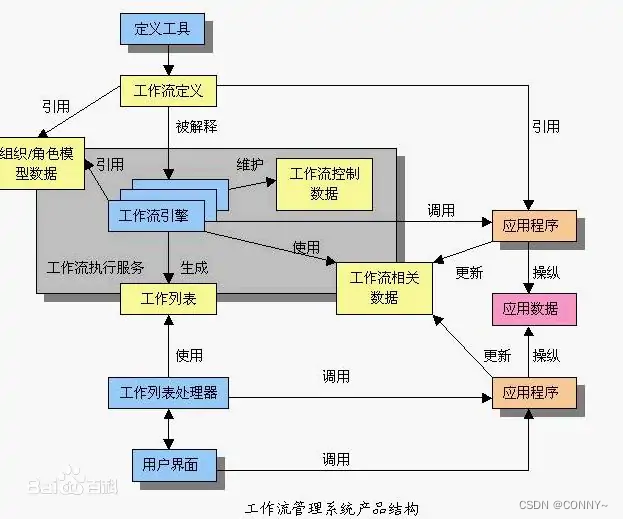工作流管理系统概述
工作流管理系统(Workflow Management System, WfMS)是一个软件系统,它完成工作量的定义和管理,并按照在系统中预先定义好的工作流逻辑进行工作流实例的执行。 工作流管理系统不是企业的业务系统,而是为企业的业务系统的运行提供了一个软件的支撑环境。
它由多个组件组成,包括工作流执行服务、工作流引擎、流程定义工具、客户端应用、调用应用和管理监控工具。
-
工作流执行服务:工作流执行服务是WFMS的核心组件,负责根据预定义的流程规则,自动执行工作流程中的各个任务,并确保任务按照指定的顺序和条件执行。它通常具有高度可靠性和可扩展性,能够处理大量的并发任务。
-
工作流引擎:工作流引擎是实现工作流执行服务的关键技术。它提供了执行和控制工作流程的功能,包括任务调度、流程状态管理、事件处理等。工作流引擎通常基于一些特定的工作流模型或标准,如BPMN(Business Process Model and Notation)。
-
流程定义工具:流程定义工具用于创建和编辑工作流程的定义,包括任务的顺序、条件、参与者角色等信息。通过流程定义工具,用户可以可视化地设计和修改工作流程,而无需编写复杂的代码。
-
客户端应用:客户端应用是工作流系统的用户界面,通过它用户可以提交工作流请求、查看任务状态、处理任务等。客户端应用通常提供了友好的界面和易用的操作方式,以便用户能够方便地使用工作流系统。
-
调用应用:调用应用是接入工作流系统的外部应用程序,它们可以通过API或其他方式与工作流引擎进行交互。调用应用可以触发工作流的执行,传递参数给工作流,获取工作流的执行结果等。
-
管理监控工具:管理监控工具用于对工作流系统进行配置、监控和管理。它提供了对工作流执行情况的实时监控和统计分析功能,可以帮助管理员及时发现和解决问题,优化工作流程的性能和效率。
总而言之,工作流管理系统通过将业务过程抽象为可执行的工作流程,提供了一种高效、自动化的方式来管理和执行各类业务流程,从而提升组织的工作效率和质量。

举个例子把,假设我们有一个电子商务平台的订单处理流程,可以使用工作流管理系统来管理和执行该流程,并包括上述六个组件,在这个例子中,当一个用户提交订单后,客户端应用将订单请求发送到工作流引擎。工作流引擎根据预先定义的流程规则,逐步驱动订单审核、库存检查、支付处理和物流安排等任务的自动执行。期间,管理员可以通过管理监控工具监视订单处理的进展情况。
-
工作流执行服务:负责实际执行订单处理流程中的各个任务,如订单审核、库存检查、支付处理、物流安排等。它确保任务按照预定的流程规则和条件顺序执行,并处理并发任务以及异常情况。
-
工作流引擎:作为核心技术,管理和控制订单处理流程的执行。它根据事先定义的流程规则和条件,驱动任务的自动执行,例如在订单审核通过后触发库存检查任务。
-
流程定义工具:用于创建和编辑订单处理流程的定义文件。定义文件中包括任务的顺序、依赖关系、参与者角色等信息。通过流程定义工具,管理员可以可视化地设计和修改订单处理流程,而无需编写复杂的代码。
-
客户端应用:提供给平台用户的界面,使其能够提交订单、查看订单状态、取消订单等。客户端应用向工作流系统提交订单请求,并显示订单处理的进度和结果。
-
调用应用:外部应用程序与工作流引擎进行交互的接口。例如,当订单支付成功时,调用应用可以通知工作流引擎更新订单状态,并触发后续的物流安排任务。
-
管理监控工具:用于管理员对工作流系统进行配置、监控和管理。管理员可以通过管理监控工具查看订单处理的实时情况,例如每个任务的执行时间、待处理任务的数量等,从而及时发现问题并进行调整和优化。























 588
588

 被折叠的 条评论
为什么被折叠?
被折叠的 条评论
为什么被折叠?










